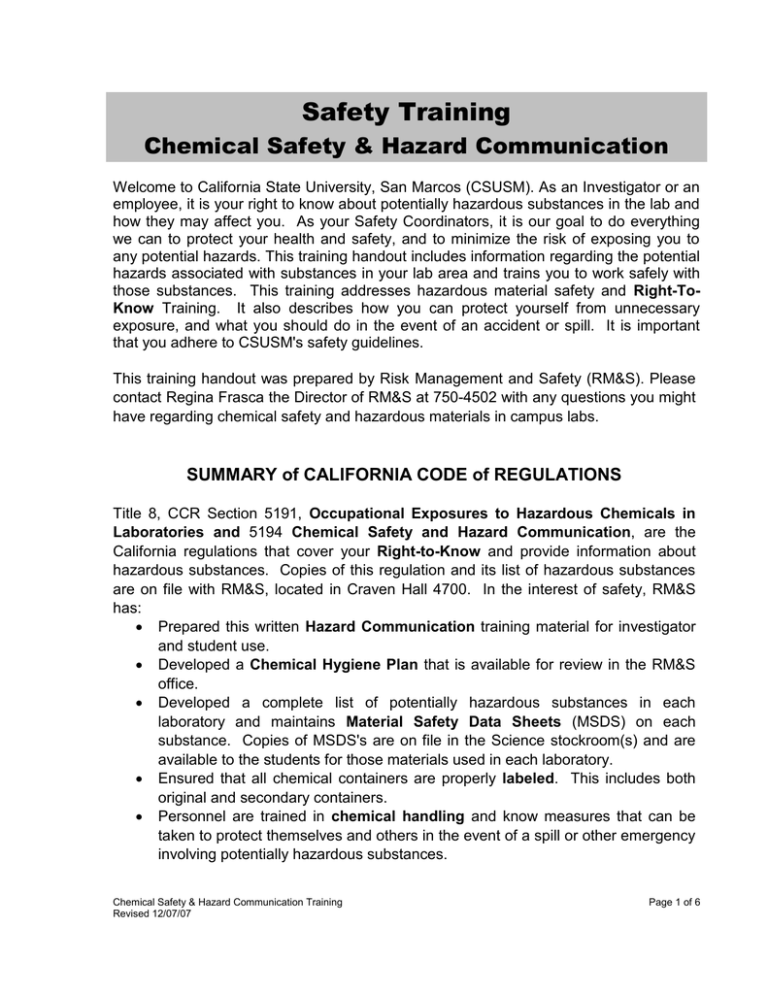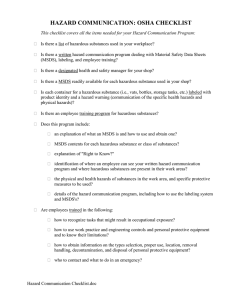Hazard Communication Lab Safety Paper Training
advertisement

Safety Training Chemical Safety & Hazard Communication Welcome to California State University, San Marcos (CSUSM). As an Investigator or an employee, it is your right to know about potentially hazardous substances in the lab and how they may affect you. As your Safety Coordinators, it is our goal to do everything we can to protect your health and safety, and to minimize the risk of exposing you to any potential hazards. This training handout includes information regarding the potential hazards associated with substances in your lab area and trains you to work safely with those substances. This training addresses hazardous material safety and Right-ToKnow Training. It also describes how you can protect yourself from unnecessary exposure, and what you should do in the event of an accident or spill. It is important that you adhere to CSUSM's safety guidelines. This training handout was prepared by Risk Management and Safety (RM&S). Please contact Regina Frasca the Director of RM&S at 750-4502 with any questions you might have regarding chemical safety and hazardous materials in campus labs. SUMMARY of CALIFORNIA CODE of REGULATIONS Title 8, CCR Section 5191, Occupational Exposures to Hazardous Chemicals in Laboratories and 5194 Chemical Safety and Hazard Communication, are the California regulations that cover your Right-to-Know and provide information about hazardous substances. Copies of this regulation and its list of hazardous substances are on file with RM&S, located in Craven Hall 4700. In the interest of safety, RM&S has: Prepared this written Hazard Communication training material for investigator and student use. Developed a Chemical Hygiene Plan that is available for review in the RM&S office. Developed a complete list of potentially hazardous substances in each laboratory and maintains Material Safety Data Sheets (MSDS) on each substance. Copies of MSDS's are on file in the Science stockroom(s) and are available to the students for those materials used in each laboratory. Ensured that all chemical containers are properly labeled. This includes both original and secondary containers. Personnel are trained in chemical handling and know measures that can be taken to protect themselves and others in the event of a spill or other emergency involving potentially hazardous substances. Chemical Safety & Hazard Communication Training Revised 12/07/07 Page 1 of 6 Developed material to inform students and CSUSM employees in proper and safe handling of potentially hazardous chemicals. Developed a requirement for outside contractors with hazardous chemicals to address employee Right-to-Know training and dissemination of information. It is important that you know that you cannot be penalized for identifying any potential hazards to your instructors. HAZARDOUS CHEMICALS Several potentially hazardous chemicals may be in use at CSUSM. These chemicals can be classified as presenting physical hazards, health hazards or any combination of these hazards. PHYSICAL HAZARDS A physical hazard produces an effect outside the body, and includes substances that are: Compressed Gases (such as nitrogen & oxygen); Explosives (e.g., hydrazine); Flammables (combustible solvents, e.g. diethyl ether); Unstable or Reactive (e.g. peroxides & picric acid), and Water Reactive (e.g. phosphorus pentoxide). HEALTH HAZARDS To present a health hazard, a substance must contact or enter the body. This entry can occur by inhalation, ingestion, or absorption of the substance through the skin. Health hazard categories include: Carcinogens (and Possible Carcinogens) - cancer causing substances (e.g. benzene) Corrosives - acids and bases Irritants - substances, which abrade or irritate the skin surface or mucus membranes (e.g. ammonia) Reproductive Toxins (mutagens and teratogens) - substances which affect your reproductive system or which may affect your offspring Sensitizers- substances, which have increased effect with chronic exposure over time rather than with short-term exposure (e.g. allergens) Toxins (poisons) - substances that may cause illness, severe irritation, and/or death The effects of hazardous substances may result from acute (immediate e.g. acid burn) or chronic (manifest themselves after extended use such as asbestos) exposures. They may also be local in nature (such as acid burn) or systemic (may be carried to other parts of the body where an effect is noticed e.g. sodium cyanide). Chemical Safety & Hazard Communication Training Revised 12/07/07 Page 2 of 6 The danger a substance presents is affected by a number of different parameters. These include the physical state of the substance that is solid, liquid, or a gaseous state. In general, gases are more hazardous than liquids, which are more hazardous than solids. Gases can easily gain entry into your body through inhalation. Some gases may be readily detected because they have distinctive odors, but many exist which are odorless. Most liquids are not hazardous until they vaporize (become gaseous) or are absorbed through the skin. Solids are the most easily collected and maintained hazardous chemicals and therefore, the least hazardous. Their primary route of entry into the body is through the inhalation of particulates. A variety of factors influence the degree of toxicity, or adverse reaction, someone may experience as a result of substance exposure. These factors include how the substance gets into the body (inhalation, ingestion, etc.), the physical condition of the person, the amount and duration of the exposure, the sensitivity of the person to the substance, stress level, the substance's combined effect with other chemicals with which the person works with, sex, race, and environmental conditions. Properly labeling substances is the primary method of advising laboratory workers about potentially hazardous substances. The label on the container provides a warning advising the contents and type of hazard (e.g. acid, base, explosive). The label also includes the name and address of the chemical manufacturer. If the contents are removed from the manufacturer's supplied container and placed in a secondary container, it is your responsibility to label the secondary container with your name, the date, the contents, and any hazard or special handling instructions. Labels must never be defaced or removed from containers unless the substance has been properly and legally discarded and the container has been properly cleaned. Manufacturers use numerous labeling procedures, all of which should provide the required information. Commonly accepted systems are the Hazardous Material Information System (HMIS), developed by the chemical industry and the National Fire Protection Association (NFPA) 704 used by fire departments and bulk storage facilities. HMIS is a four bar color system using: Blue, Red, Yellow (or Orange) and White. Sample HMIS Label 4 4 4 PPE Health Hazards Flammability Reactivity/Dangerous Characteristics Personal Protective Equipment The NFPA label identifies the chemical (with common or chemical name). They are diamond shaped with red, blue, yellow, and white sections. The red, blue, and yellow sections contain numerical codes (scale 0 to 4, 4 being most severe) which indicate the degree of hazard of each type: Check the label on each chemical you use. The Chemical Safety & Hazard Communication Training Revised 12/07/07 Page 3 of 6 information supplied on the label and the Material Safety Data Sheet, will advise precautions to use when handling that chemical. If the label is missing or defaced, do not use the chemical and report the unlabeled container to your instructor. Sample NFPA 704 Label Flammability 4 4 Health Hazard Reactivity 4 Special Hazard Warning (i.e. “OX” = Oxidizer MATERIAL SAFETY DATA SHEETS Every manufacturer of chemicals is required to provide a Material Safety Data Sheet (MSDS) for each chemical they produce. Users of chemicals should have a MSDS available for each chemical they use. Each stockroom will have MSDS's for every chemical available. Before working with any chemical, you should always check the label and read the MSDS. Ask your instructor where these MSDS's are located (generally in the following areas: Chemistry/Biology stockrooms and the RM&S office). MSDS's outlines special hazards, and recommend safe handling procedures. The MSDS also prescribes any personal protection that should be worn when handling or using the chemical. PROTECTING YOURSELF FROM EXPOSURE The first step in protecting yourself from potential exposures to chemicals is to ensure that you know how to use the chemical properly. Read the label, the MSDS, and follow the instructions they provide you for using the chemical. CSUSM provides special equipment to facilitate safe use of chemicals. However, you are responsible for providing the most important safety equipment: AN ATTITUDE OF AWARENESS, safety goggles and appropriate clothing (described below). Special equipment provided by CSUSM includes but is not limited to: cabinets for storage of flammables, acids, bases, combustibles and radioisotopes; designated areas for spill containment; eyewash and emergency shower stations equipped with spill-kits; warning signs; and fume hoods. USE of PERSONAL PROTECTIVE EQUIPMENT Personal protective equipment can help minimize the exposure you have to chemicals. CSUSM requires laboratory personnel to obtain their own safety goggles for use when in the science labs. Eye protection must always be worn when working in areas where chemicals can splash into the eye. In addition, Investigators in laboratories are required to dress appropriately. Researchers wearing shorts, short skirts, open-toed shoes or Chemical Safety & Hazard Communication Training Revised 12/07/07 Page 4 of 6 sandals will not be permitted to work in the lab. Investigators are not allowed to eat, drink, chew tobacco, or apply cosmetics inside campus laboratories. Adherence to RM&S guidelines as described herein greatly contribute to reducing YOUR EXPOSURE. DEALING WITH EMERGENCIES In the event of a spill: Do not attempt to clean the spill yourself! Evacuate the contaminated area(s). Alert your supervisor/instructor immediately. Chemical Safety & Hazard Communication Training Revised 12/07/07 Page 5 of 6 ACKNOWLEDGEMENT You will not be permitted to work in campus laboratories until you: Have completed this training Have been instructed by the Safety Coordinator in Chemical Safety and Hazard Communication Have had your questions answered Have completed the Hazard Communications Quiz Have signed your training acknowledgement I affirm that I have been trained in Chemical Safety and Hazard Communication. Name (Print): ________________________________ Date: ___________________ Signature: _________________________________________________________ Safety Coordinator Signature: ____________________________________________ ** Please maintain the training handout for your reference and return the signed acknowledgement page to Risk Management and Safety. Chemical Safety & Hazard Communication Training Revised 12/07/07 Page 6 of 6



